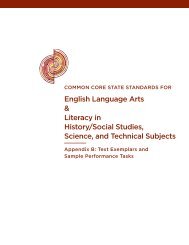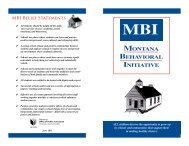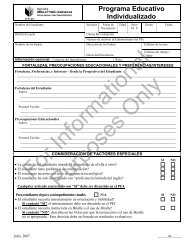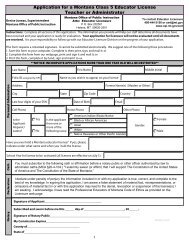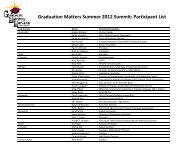OT/PT Guidelines - Montana Office of Public Instruction
OT/PT Guidelines - Montana Office of Public Instruction
OT/PT Guidelines - Montana Office of Public Instruction
You also want an ePaper? Increase the reach of your titles
YUMPU automatically turns print PDFs into web optimized ePapers that Google loves.
SERVICE DELIVERY<br />
In order to integrate physical therapy and occupational therapy services effectively within the<br />
school setting, the therapist must understand the special education process and educational model<br />
<strong>of</strong> service delivery.<br />
Referral (Request for Initial Evaluation). Occupational and physical therapy referrals shall be<br />
consistent with the policies and procedures <strong>of</strong> public school districts or special education<br />
cooperatives. A referral for evaluation shall include documentation from a school-based support<br />
team (pre-referral) process and/or screening procedures.<br />
Screening: Procedures for gathering data from a specified group <strong>of</strong> students, such as all<br />
first and third-grade students, to determine whether additional evaluation information<br />
regarding a suspected disability should be pursued by the school district through informed<br />
parental consent for an evaluation for eligibility for special education and related services.<br />
Parents are informed by the district <strong>of</strong> its screening procedures. Individual parental<br />
consent is not required for screening. It also means a procedure for school pr<strong>of</strong>essionals<br />
to determine appropriate instructional strategies for curriculum implementation.<br />
If screening procedures indicate that a referral to special education for evaluation is necessary, a<br />
written referral shall be made and parent consent for the initial evaluation obtained. A referral<br />
for evaluation shall include written notice, which meets the requirements <strong>of</strong> the Administrative<br />
Rules <strong>of</strong> <strong>Montana</strong> (ARM).<br />
Educational Evaluation. An occupational therapy or physical therapy assessment in the school<br />
setting may be one component <strong>of</strong> the educational evaluation if the student’s suspected disability<br />
falls within one or more <strong>of</strong> the domains. Each member <strong>of</strong> the evaluation team should be<br />
appropriately notified according to school district procedures.<br />
The therapist’s judgment will determine the nature and extent <strong>of</strong> the evaluation based on the<br />
student’s suspected disability and how this disability impacts the student’s functional school<br />
performance, movement and mobility skills, sensory processing and regulation, and life skills.<br />
Often inventories, checklists, caregiver and/or teacher interviews and non-standardized tests are<br />
appropriate assessment methods to obtain an accurate picture <strong>of</strong> the student’s sensory motor<br />
status and functional performance level in school.<br />
Physical therapy and occupational therapy evaluations provide neuromotor and developmental<br />
information <strong>of</strong> the student’s functional capabilities for the multidisciplinary team to consider.<br />
These evaluations also assist the team in determining the foundations and causes for the<br />
functional deficits that affects the student’s ability to learn. The therapists’ written report should<br />
describe the educational implications <strong>of</strong> the functional impairment and list what interventions are<br />
needed (seating, mobility aids, adapted physical education, etc.)<br />
14



